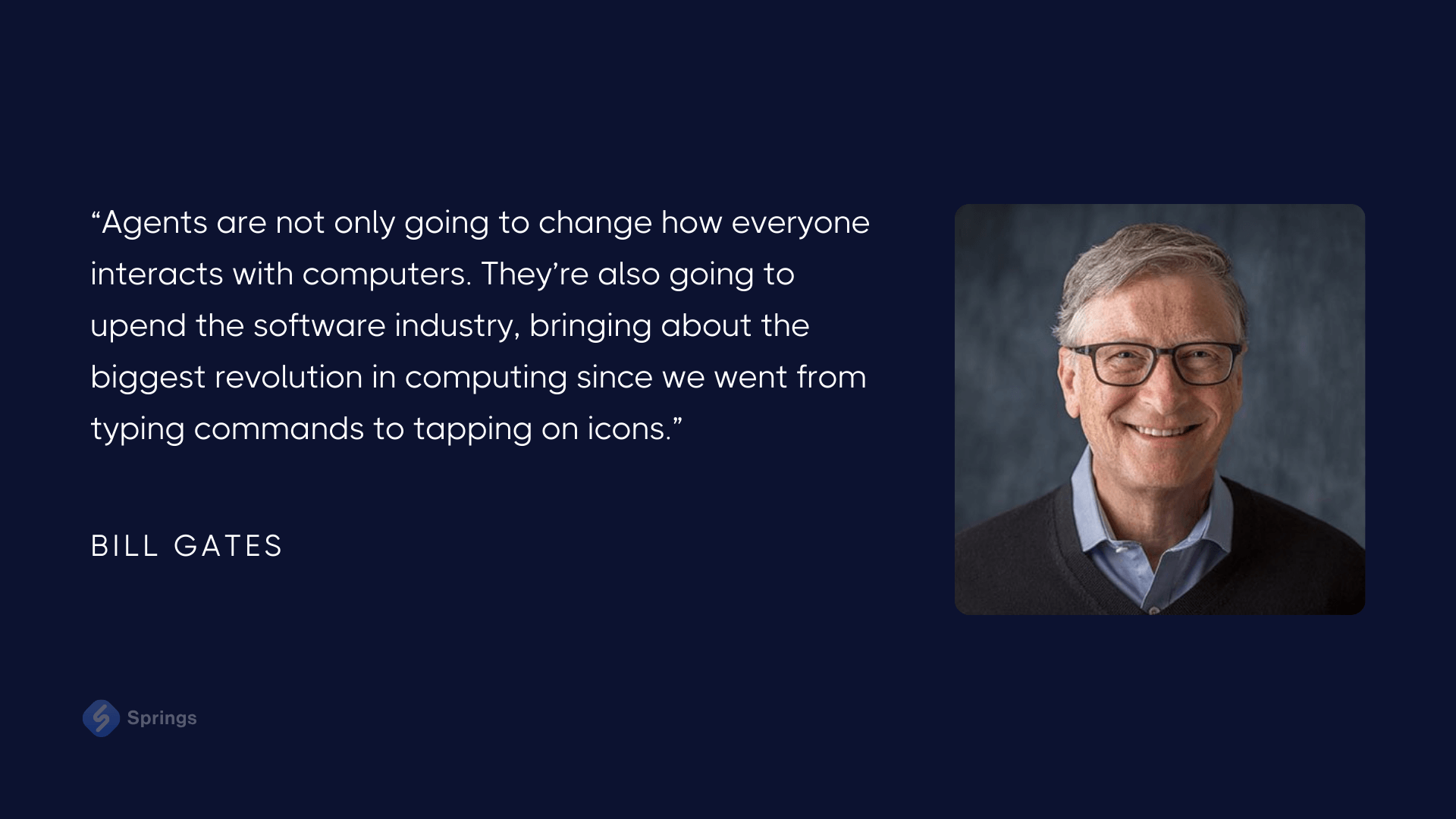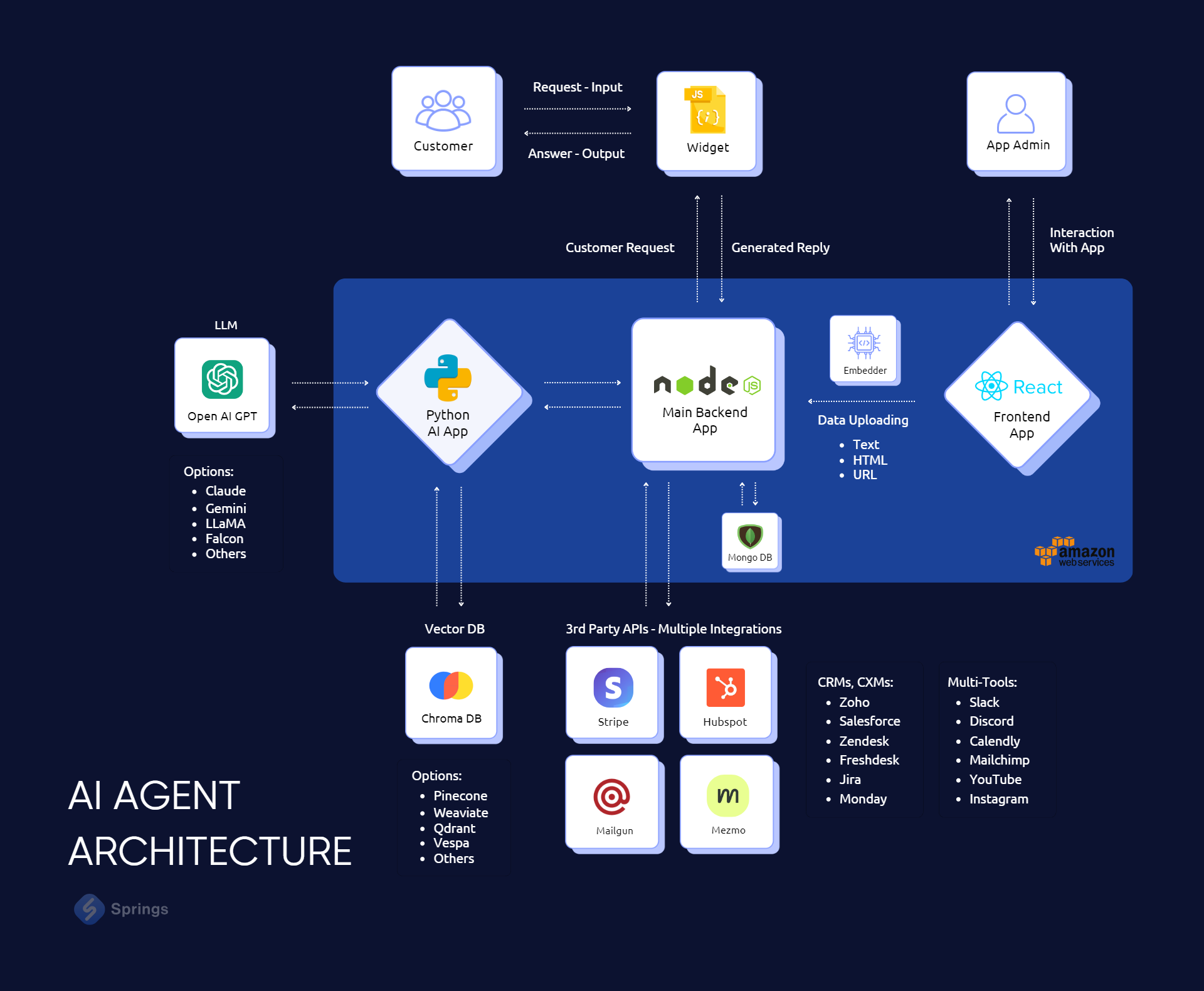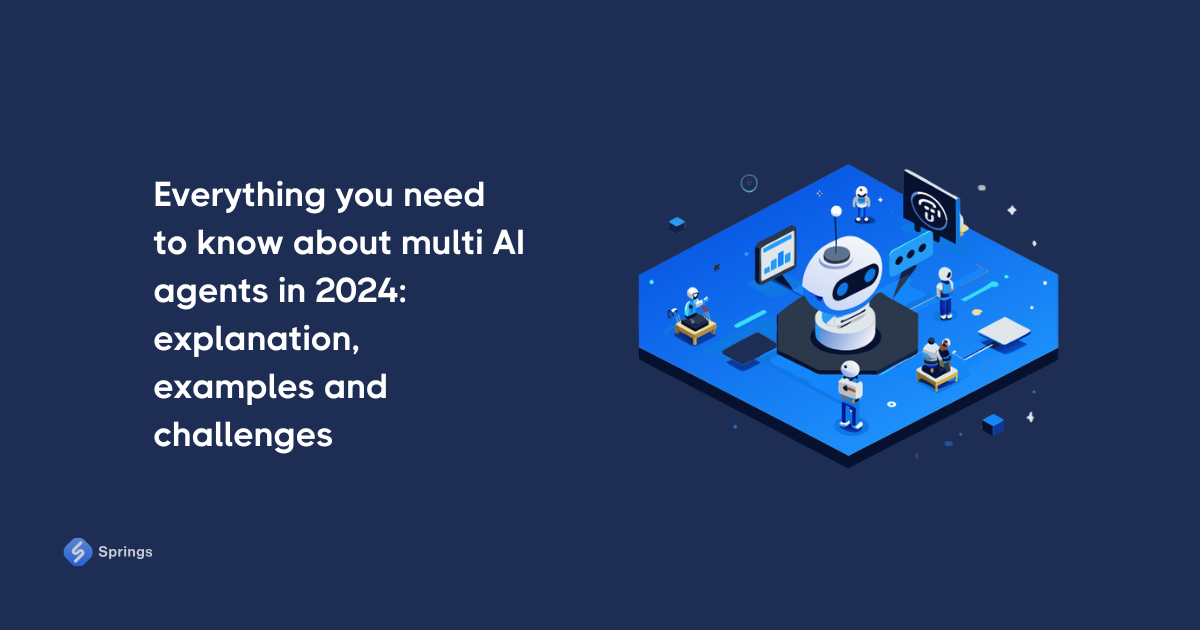How To Build Your Own AI Agent
Intro
"An AI agent can respond to your messages 24/7, when a person is still asleep at 2AM," according to Nancy Xu, Chief Executive Officer of AI recruitment company Moonhub. What else autonomous AI agent can do?
This was the subject of a highly anticipated panel session – What Can AI Assistants Do? – at the World Economic Forum's Annual Meeting of the New Champions in Dalian, China in June. One of the speakers of the forum was: Xi Kang - Assistant Professor, at Owen Graduate School of Management, Vanderbilt University.
For Kang, an AI agent or assistant is "any algorithm or models powered by AI or related technology that can help people make predictions about the future or make decisions, if it is approachable enough for laymen to interact with it, to get some insights from it." In her view, this encompasses a wide range of AI development solutions created to assist users in navigating complex information and making informed choices based on accessible and user-friendly interactions.
So, let us try to find out the basics of custom AI agents, their key capabilities, and, most importantly, how to build them step by step. We'll explore the fundamental concepts behind AI agents, diving deeper into their architecture and core functionalities. By the end, you'll have a clear understanding of the agent development process, enabling you to create your own custom AI agent platform.
Understanding of AI Agents
One of the easiest ways to understand AI Agents is to start with their well-known versions - AI Chatbots. You may find a lot of articles about this type of autonomous AI agent in our blog, however, in this one, we are going to remind you shortly about its key features.
So, the key features of an AI chatbot as an AI agent may include:
- Natural Language Processing (NLP)
- Contextual Understanding
- Self-Learning Capabilities
- 24/7 Availability
- Task Automation
- Scalability
A chatbot could be a great example of an agent as custom AI Agents are usually developed to automate tasks such as answering customers, research, data analysis, and content creation.
Autonomous AI agents stand out due to their proactive nature and decision-making abilities. Unlike passive tools, these agents actively interact with their environment, making choices and executing actions to achieve their specified objectives. Their dynamic engagement ensures that they are not just reacting to inputs but are also strategically working towards their goals.
A necessary feature of AI agents is their ability to learn and adapt. Using modern technologies such as large language models, these agents continually update their performance based on previous interactions. When we talk about autonomous AI agent systems, multiple agents can play roles similar to members of a professional team. Obviously, autonomous agents are becoming game-changer tools in the new tech era.

By using an autonomous AI agent, you can develop custom generative AI solutions that seamlessly integrate into your projects, significantly saving time and enhancing productivity.
Moreover, the implementation of custom AI Agents allows you to accomplish more tasks efficiently and intelligently.
Architecture of AI Agent
In the modern world of AI agent development, the architecture of agents plays a significant role in determining their behavior and capabilities. Understanding these architectures is key to understanding how AI agents operate, make decisions, and solve business problems.
So, let us determine three major types of agent architectures that form the foundation of AI agents: Reactive Agents, Deliberative Agents, and Hybrid Agents.
Reactive Agents
Reactive agents operate based on the current state of their environment, instantly reacting to changes without the use of internal models, like LLMs, or historical data. These agents are created to respond in real time, making them highly efficient in dynamic and unpredictable environments. For example, a reactive agent might be integrated into an automated customer support agent, which needs to adjust its path immediately due to the replies of the customer.
Technically, reactive agents rely on a set of condition-action rules, sometimes referred to as production rules. These rules are usually straightforward and understandable: "If condition A is true, then perform action B." The simplicity of this architecture enables fast processing and execution, making reactive agents ideal for tasks that require immediate responses.
Deliberative Agents
Deliberative agents, on the other hand, are the strategists of the custom AI agents. They use internal models to plan actions by considering the future consequences of their actions. This approach allows them to perform complex strategies and make informed decisions based on a comprehensive understanding of their environment.
Such an autonomous AI agent is equipped with a rich knowledge base and advanced reasoning technologies. A usual example of a deliberative agent is an autonomous vehicle, that is able to plan its route, anticipate traffic conditions, and make decisions based on a multitude of factors to ensure safe and efficient road travel.
Hybrid Agents
Hybrid agents are the most powerful machines in terms of AI agent platforms, as they combine the architecture of both previous models. In other words, hybrid custom AI agents can respond immediately to environmental changes while also engaging in long-term planning based on modeled outcomes. Such agents can switch between reactive behavior and deliberative planning as the situation demands, making them exceptionally adaptable and robust.
From a technical perspective, hybrid agents are often powered by layered architectures. One of the most popular types of architecture is the three-layer architecture, consisting of a reactive layer for immediate response, a deliberative layer for planning, and a coordination layer to manage the interaction between the two. This structure enables agents to perform a wide range of tasks, from real-time responses in fast-paced environments to strategic planning in complex scenarios.

From the schema above, we may see that AI agent architecture is usually presented by the following key elements:
- User Input, where the user can ask an agent to perform some action (process data, answer the question, etc.)
- Frontend Application, where we can interact with an agent via a user interface and use all its developed functionality.
- Backend Application, where the agent processes all the actions and connects with other services or applications, interacts with the frontend app.
- AI Application, where “all the magic” happens. In other words, the machine learning models or other AI algorithms process the data and provide the output we expect to receive at the end.
- Additional Elements: admin panel, 3rd party services connected via API (like Hubspot, Mailgun or ChatGPT-4o, embedder, etc.
- Cloud Environment: AWS, Google Cloud, or any other service can be used to host AI agents and make it possible to run smoothly.
Overall, the architecture of AI agents shows their style and potential effectiveness in various use cases. As AI technologies continue to grow, these architectures will play an increasingly important role in developing intelligent systems capable of tackling a diverse array of challenges. Whether it's for instantaneous reactions, strategic planning, or a blend of both, understanding these core architectures is essential for anyone interested in the field of artificial intelligence.
How to Build AI Agents With Springs: Essential Steps
We are close to the super exciting part of our journey - answering the question of how to create AI agent or how exactly to build AI agent without coding or being a programmer.
Step 1. Sign Up
So, the first step will be simple - you just need to visit our homepage and click on the “Free Trial” button.
As soon as you are redirected to our AI Agent Builder IONI, all you have to do is proceed with the straightforward registration steps. That’s it. If you registered successfully, you may sign in and will be redirected to the homepage automatically.
Your homepage shows you a graph of your customers’ interactions. Don’t worry if it is blank from the start - it will be filled as soon as they start to act with your agents.
Step 2. Fill Knowledge Base
Before creating multiple agents we suggest you test your already existing agent integrated into the platform - the AI chatbot. Only then we suggest to build AI agent from scratch.
For these, please go to the Knowledge Base page and fill it with the data you would like to be processed by the agent. You may use regular text, HTML, or a single URL data uploading option.
Step 3. Create AI Agent
Now, we are ready to create AI agent ourselves. Please, move to the AI Agent page.
Note! There is already a pre-installed (default) agent for you. So, if you do not need to create multiple agents, you may just customize the existing one using the “Branding”, “Call to Action” and “Settings” tabs.
If you would like to build AI agent additionally, feel free to click the “Create AI Agent” button in the upper right corner.
Put the name of your other agent and click “Create”. That’s it! Now, you may test and use your other AI agent on other websites, business applications, and so on.
Customization
The world of AI technologies is unlimited but not all of them can be used to fine-tune and tailor AI agents. Customizing AI agents involves a variety of AI and ML frameworks, tools, and services, depending on business goals, such as building NLP chatbots, recommendation systems, computer vision models, or other AI agents.
AI Frameworks and Libraries
- TensorFlow. A popular open-source library by Google for building and training deep learning models. It is usually used for neural networks, computer vision, and NLP.
- PyTorch. An open-source ML library developed by Facebook’s AI Research lab. It’s known for its flexibility and ease of use, particularly for research and development of deep learning models.
- Keras. A high-level neural networks API, coded in Python, capable of running on top of TensorFlow, CNTK, or Theano. It significantly simplifies building deep learning models.
- Hugging Face. A huge library of AI tools that provides a collection of pre-trained models for different business tasks such as text classification, translation, summarization, and more. It supports both PyTorch and TensorFlow.
- Scikit-learn. ML-based library in Python that provides simple and efficient tools for data analysis, built on NumPy, SciPy, and Matplotlib.
AI Cloud Services
- Google Cloud AI. Google AI Cloud offers a suite of tools such as AutoML, TensorFlow Extended (TFX), Vertex AI, and pre-trained models for a variety of AI tasks.
- AWS AI. AI-powered AWS provides services like Amazon SageMaker for building, training, and deploying machine learning models, Rekognition for image analysis, and Lex for conversational interfaces.
- Microsoft Azure AI. MS Azure AI provides services like Azure Machine Learning, Cognitive Services, and Bot Service, which allow you to integrate AI into agents easily.
- IBM Watson. IBM company provides a range of AI services like Watson Assistant for chatbots, Watson Studio for model building, and Watson Natural Language Understanding for text analysis.
Conversational AI Platforms
- Rasa. An open-source framework for building conversational AI, including chatbots and AI assistants. It offers tools for intent recognition, dialogue management, and custom NLU components.
- Dialogflow. Dialogflow is a Google-based platform for natural conversational AI development. It uses NLP to understand and respond to user input and can integrate with multiple channels.
- Microsoft Bot Framework (MBF). MDF provides a set of services for building bots that can integrate with various messaging platforms. It includes Azure Bot Service and the Language Understanding (LUIS) model for intent recognition.
Computer Vision Tools
- OpenCV. OpenCV is one of the most popular open-source computer vision libraries that provides tools for image and video analysis, including object detection, face recognition, and more. It is usually used with Python programming language.
- Detectron2. This is Meta’s AI Research library providing state-of-the-art detection and segmentation algorithms.
- YOLO (You Only Look Once). YOLO is a real-time object detection AI service that uses a single neural network to the full image, dividing the image into regions and predicting bounding boxes.
Data Processing AI Tools
- Labelbox. This is an AI platform for training data labeling and management, useful for computer vision, NLP, and other AI/ML tasks.
- Amazon SageMaker. ASM is a data labeling service that provides highly accurate training datasets for machine learning models.
- SuperAnnotate. This is an AI data platform tool for image and video annotation that accelerates the creation of training data for multiple computer vision tasks.
Overall, these tools and technologies provide a great opportunity for professionals to customize AI agents to fit specific use cases, whether you're working on AI chatbots, computer vision solutions, reinforcement learning, or other business apps.
Conclusion
The growth of AI agents is expected to speed up significantly in the coming years, driven by advancements in machine learning, natural language processing, and autonomous AI technologies.
AI agents will be more and more integrated into various industries, from customer service chatbots and AI assistants to complex computer vision systems in healthcare, fintech, and logistics. As these technologies evolve, AI agents are becoming more sophisticated, and capable of understanding and responding to human inputs in more natural and contextually relevant ways. This progress is also fueled by the growing availability of large datasets and more powerful computing resources, allowing AI agents to learn and adapt more effectively.
Moreover, as AI agents become more practically useful in everyday applications, their role in society is expected to expand significantly. They will not only assist with routine tasks but also provide personalized services, improve processes for decision-makers, and even collaborate with humans in creative industries like logo design, graphic illustrations, and so on.
This will likely lead to a greater reliance on AI in both professional and personal contexts, potentially transforming how we work, communicate, and interact with technology. So, we are moving to a new era - the period of AI employees and human-AI job cooperation.





